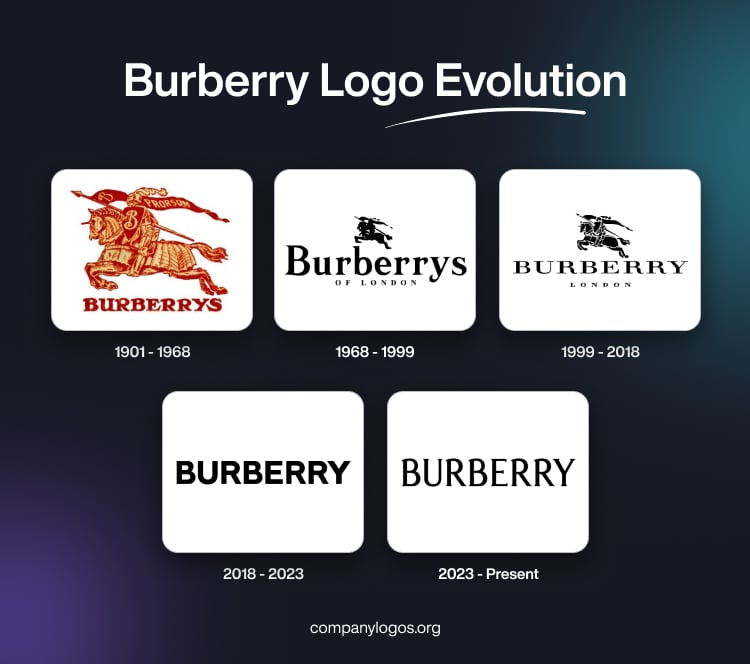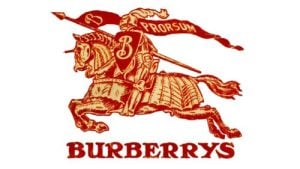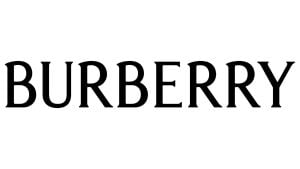
Burberry is a world-renowned British luxury fashion house celebrated for its timeless style, craftsmanship, and innovation. Founded in 1856 by Thomas Burberry, the brand began with a mission to create functional outerwear suited to the unpredictable British climate. Over the decades, Burberry has grown into a global symbol of elegance and resilience.
With its deep roots in British heritage and its strong ties to exploration, military history, and cinema, Burberry has established itself as much more than a fashion brand. The history and evolution of the Burberry logo reflects the brand’s heritage, values, and adaptability to changing fashion trends. This article explores the fascinating journey of the evolution of the Burberry logo, among other details of the company.
The Genesis of the Burberry Logo (1901 – 1968)
The first recognizable Burberry logo emerged in 1901 and it showcased a red emblem comprising an equestrian knight astride a horse. The knight held a shield bearing the Latin word “Prorsum” to signify “forward” in English. Positioned above the brand name in a bold serif font in uppercase, this emblem encapsulated Burberry’s heritage and its ties to the British aristocracy.
Also, the equestrian motif held special significance. It reflected Burberry’s origins as a manufacturer of outdoor apparel for hunters and sports enthusiasts. Besides its connection to the British aristocracy, the emblematic motif reflected the brand’s connection to the British countryside and its association with outdoor activities.

(1968 – 1999)
In 1968, the redesigned logo featured the brand name in title case using a sans-serif font. The equestrian emblem became smaller and showed only a black silhouette. The wordmark in a title case was written using a serif typeface. Below it appeared the tagline “OF LONDON” written using the same serif typeface as the brand name above.

(1999 – 2018)
In 1999, Burberry underwent another logo transformation. The updated design balanced the sizes of the emblem and the wordmark to look professional and classy. The equestrian rider of the emblem was shown in black and white, while the wordmark in all capitals appeared in a sans-serif font. The letters of the wordmark had sleek lines and thin pointed serifs. The word “OF” was removed from the tagline, which showed only “LONDON” in uppercase, albeit in a smaller size.

(2018 – 2023)
In 2018, the new logo was designed by Peter Saville who removed the equestrian knight and the word “London”. The new logo with a modern look featured only the wordmark written in a simplified sans-serif typeface in black.

(2023 – Present)
In the 2023 iteration of the Burberry logo, the typeface takes a bold departure from its predecessors. The minimalism of recent years gives way to a fanciful and elegant font that commands attention. The logo featured subtle flairs, playful serifs, and slightly flared bold bars. Now rendered in sleek black, the refined wordmark in uppercase letters conveys a more feminine and spirited aura. The font is similar to Valeson Condensed Regular and Moonllys Regular.

The Elements of the Burberry Logo
Symbol
The renowned “equestrian knight” Burberry logo stands out as one of the most iconic symbols in the world of fashion. The visual identity of Burberry encapsulates an image of a horse rider carrying a shield. While the shield represents protection, the equestrian element conveys a sense of grandeur, pride, and purity.
Font
The present Burberry wordmark is rendered in uppercase letters, and employs a modern sans-serif font. It is similar to the Urania Extra Bold typeface designed by Dieter Hofrichter.
Colour
The inclusion of black in the logo symbolizes the elegance, durability, and strength inherent in Burberry’s products.
The History of Burberry
Burberry was founded in 1856 by Thomas Burberry, who was a 21-year-old draper’s apprentice, in Basingstoke, Hampshire, England. His goal was to create clothing designed to protect people from the unpredictable British weather. The brand initially focused on outdoor attire and offered practical garments rather than high-fashion pieces.
In 1879, Thomas Burberry revolutionized outerwear by inventing gabardine, which is a tightly woven, water-resistant yet breathable fabric. Unlike traditional waterproof materials of the time, gabardine was lightweight, comfortable, and durable. It quickly gained popularity among explorers and adventurers.
By the late 19th century, Burberry had become well-established. In 1891, the company opened its first London store in Haymarket. Burberry garments were worn by explorers such as Norwegian polar explorer Roald Amundsen (the first man to reach the South Pole in 1911) and Ernest Shackleton during his Antarctic expeditions. This cemented the brand’s association with endurance and adventure. In 1901, the Burberry Equestrian Knight logo was introduced as a symbol to showcase the commitment of the company to innovation and progress. The knight carried a banner inscribed with the Latin word “Prorsum”, meaning forward.
During the First World War, Burberry was commissioned by the British War Office to adapt its officer’s coat into what would become the trench coat. Made from gabardine, it was practical for soldiers in the trenches. It featured epaulettes, D-rings, and storm flaps. After the war, the trench coat transitioned into civilian fashion. It became a timeless wardrobe staple and one of Burberry’s most enduring products. In the 1920s, Burberry introduced its now-famous Burberry Check (a beige background with black, white, and red plaid). Initially used as a lining for trench coats, the check later became a defining symbol of the brand.
By the mid-20th century, Burberry was recognized globally as a symbol of British sophistication. Celebrities, royalty, and public figures, including Queen Elizabeth II and Winston Churchill, wore Burberry coats. The company was awarded two Royal Warrants: one by Queen Elizabeth II in 1955 and another by the Prince of Wales in 1989.
During this period, Burberry diversified its offerings beyond outerwear into accessories, ready-to-wear clothing, and fragrances. In the 1990s, Burberry faced a decline in prestige as its famous check pattern became overexposed and associated with counterfeit goods and street culture. The brand was seen as losing its exclusivity.
A major turnaround came under the creative direction of Christopher Bailey (appointed in 2001) and CEO Angela Ahrendts (2006–2014). They modernized Burberry’s image by blending its heritage with contemporary fashion. The brand also embraced digital innovation early, wherein it live-streamed runway shows and used social media for marketing.
Burberry has since reclaimed its status as a global luxury powerhouse. Under Bailey, the brand emphasized its British roots while appealing to younger generations. In 2018, Italian designer Riccardo Tisci took over as Chief Creative Officer. He introduced a new logo (sans-serif “Burberry” wordmark) and monogram pattern inspired by the initials of founder Thomas Burberry. In 2022, Daniel Lee became Chief Creative Officer, which marked another new chapter for the brand. His vision emphasizes heritage, craftsmanship, and sustainability, which aligned Burberry with modern luxury consumers’ values.
Burberry stands as one of the most recognizable luxury brands in the world. From its invention of gabardine and the iconic trench coat to its modern digital-first approach, Burberry has consistently evolved while staying true to its British identity. The Burberry Check, the trench coat, and the knight emblem remain timeless symbols of innovation, elegance, and resilience.
Interesting Facts About Burberry
- Thomas Burberry was just 21 years old when he founded the company in 1856 in Basingstoke, England.
- In 1879, Burberry introduced gabardine, which is a water-resistant yet breathable fabric that changed outerwear forever. It was lighter and more comfortable than rubberized raincoats of the era.
- Burberry clothing was worn on legendary expeditions: Roald Amundsen wore Burberry on his 1911 South Pole expedition, and Ernest Shackleton wore it during his Antarctic voyages.
- The iconic trench coat was designed for British soldiers in the First World War. Its functional details, such as epaulettes and storm flaps, still remain today.
- The famous beige check pattern was introduced in the 1920s as a trench coat lining. Over time, it became one of the most recognized patterns in fashion history.
- Burberry holds two Royal Warrants: one from Queen Elizabeth II (1955) and another from the Prince of Wales (1989).
- The Burberry trench coat became a cinema icon when it was famously worn by Humphrey Bogart in “Casablanca” (1942) and Audrey Hepburn in “Breakfast at Tiffany’s” (1961).
- Introduced in 1901, the logo was the first registered trademark for Burberry. The knight’s banner carried the word “Prorsum”, Latin for forward.
- By the 1990s, Burberry’s image was diluted due to counterfeits and overexposure. However, under Christopher Bailey and Angela Ahrendts, the brand reinvented itself.
- Burberry was the first luxury brand to live-stream a fashion show online in 2010, which set a new standard for fashion marketing.
- The Burberry trench coat remains one of the most imitated garments in the world.
- In 2018, Riccardo Tisci introduced a new minimalist logo and a monogram design based on the initials of Thomas Burberry.
- Burberry has pledged to become climate positive by 2040, with a focus on sustainable fabrics and responsible sourcing.
Finally
The evolution of the Burberry logo reflects the brand’s ability to adapt to changing times while staying true to its heritage. From the early days of the equestrian knight symbolizing outdoor adventure to the modern, sleek designs of today, each iteration of the logo tells a story of Burberry’s journey through the fashion landscape.